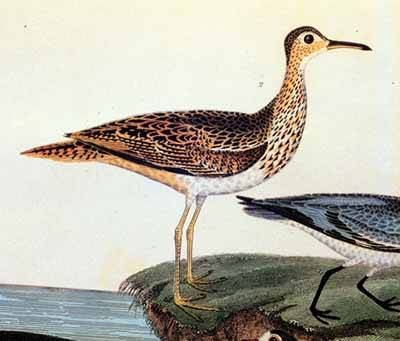
Hand-colored plate from American Ornithology, v.7 by Wilson, Alexander, published by Porter and Coates, Philadelphia, no date.
Illinois State Museum collection
Upland Sandpiper
(Bartramia longicauda)
Interesting facts:
Usually sandpipers are associated with seashores and wetlands. The Upland Sandpiper is adapted to the prairie. It arrives in northern and central Illinois in mid-April, breeds, and stays until late August, when it migrates to Argentina and Uruguay.
Description:
An Upland Sandpiper is 11-12 inches long and weighs 6 to 7 ounces. Its wingspan is about 20 inches. Its body is brown, streaked with buff and black marks. The legs are yellowish-gray. The bill is black on top and yellow below. The neck, chest, and belly are whitish streaked with dark. The rump and tail are blackish.
Habitat and behavior:
Upland Sandpipers live in grasslands. The male and female make a nest by scraping a bowl-shaped hollow in the ground and lining it with leaves and grass. By mid-May or mid-June the female lays 3 or 4 pink-spotted tan eggs that hatch in about 21 days. The young mature quickly and are ready to migrate with adults in late August.
Food:
Upland Sandpipers use their long beaks to grab insects off the blades of grass. The insects they eat include grasshoppers, crickets, beetles, moths, ants, and flies. They also eat spiders, larvae, and worms.
Distribution and status:
In Illinois the Upland Sandpiper is an endangered species. There were hundreds of thousands in 1888. They are endangered because of over-hunting and the loss of pasture or grassland acreage to intensive farming. Only a small fraction of the population of this species still nests in Illinois today.